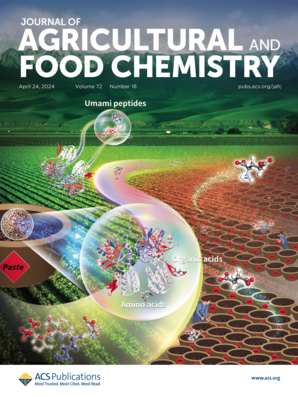Loop Dynamics Perturbation Enhances the Catalytic Stability of GH18 Family Chitinases.
IF 6.2
1区 农林科学
Q1 AGRICULTURE, MULTIDISCIPLINARY
引用次数: 0
Abstract
Enhanced thermostability is crucial for industrial biocatalysts, yet it often compromises the catalytic activity by restricting functional flexibility. Loop regions, with their intrinsic structural flexibility, have become key targets to improve thermostability while maintaining catalytic efficiency. In this study, we revealed that the dynamics of heat-sensitive loop2 and loop4 played a critical role in regulating the catalytic stability of GH18 chitinase SsChi18A by molecular dynamics simulations coupled with alanine scanning, providing a basis for function-driven enzyme optimization. The high flexibility of loop2 likely facilitated substrate capture and enhanced catalytic stability at elevated temperatures. Mutations A43T, Q41K, and Q41R increased enzyme half-life by 3, 6, and 7.5 h, respectively, and boosted activity by 23-30%, mainly by stabilizing the loop2 edge. Loop4 enhanced thermal stability by dynamically stabilizing the proton-donor Glu through intramolecular interactions, with hyperthermophilic chitinases featuring a 10-residue extended loop4 that contributes up to a value of -2979 kJ/mol in intramolecular interactions. The A189 V mutation of SsChi18A extended the half-life by 35 h and boosted chitinase activity by 34% through enhancing hydrophobic interactions. The function-driven design strategy precisely modulated loop dynamics through intramolecular interactions (e.g., hydrogen bonding and hydrophobic packing), overcoming the activity-stability trade-off and providing a framework for developing thermostable biocatalysts.环动力学扰动增强GH18家族几丁质酶的催化稳定性。
增强的热稳定性对工业生物催化剂至关重要,但它往往通过限制功能灵活性而损害催化活性。环区由于其固有的结构灵活性,已经成为在保持催化效率的同时提高热稳定性的关键目标。本研究通过分子动力学模拟和丙氨酸扫描,揭示了热敏性loop2和loop4的动力学在调节GH18几丁质酶SsChi18A的催化稳定性中发挥了关键作用,为功能驱动酶的优化提供了基础。loop2的高柔韧性可能促进了底物捕获并增强了高温下的催化稳定性。突变A43T、Q41K和Q41R分别使酶的半衰期延长了3、6和7.5小时,活性提高了23-30%,这主要是通过稳定loop2边缘实现的。Loop4通过分子内相互作用来动态稳定质子供体Glu,从而增强了热稳定性,而超嗜热几丁质酶具有10个残基延伸的Loop4,其分子内相互作用的贡献值高达-2979 kJ/mol。SsChi18A的A189 V突变通过增强疏水相互作用使其半衰期延长了35 h,几丁质酶活性提高了34%。功能驱动的设计策略通过分子内相互作用(例如氢键和疏水填充)精确调节环动力学,克服了活性与稳定性之间的权衡,并为开发热稳定型生物催化剂提供了框架。
本文章由计算机程序翻译,如有差异,请以英文原文为准。
求助全文
约1分钟内获得全文
求助全文
来源期刊
CiteScore
9.90
自引率
8.20%
发文量
1375
审稿时长
2.3 months
期刊介绍:
The Journal of Agricultural and Food Chemistry publishes high-quality, cutting edge original research representing complete studies and research advances dealing with the chemistry and biochemistry of agriculture and food. The Journal also encourages papers with chemistry and/or biochemistry as a major component combined with biological/sensory/nutritional/toxicological evaluation related to agriculture and/or food.

 求助内容:
求助内容: 应助结果提醒方式:
应助结果提醒方式:


